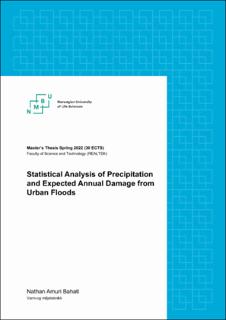| dc.description.abstract | Expected damage costs of a pluvial flood is obtained from the product of probability of failure and cost associated with the failure, for which intensity duration frequency (IDF) relationships play a critical role in determining the precipitation amount for specific return periods which are in turn functions of precipitation durations. The construction of intensity duration frequency goes back to as early as 1932(Bernad 1932). The curves play a very important role in designing of urban infrastructures such as bridges, roads, culverts, and dams. Basically, these curves are constructed by considering different durations regardless of their relations to each other. The main objective of this thesis is to investigate the extent at which extreme rainfall events of different durations are related to each other (overlaps) and assess whether the results obtained from such analysis would be of practical relevance in determination of expected annual damage (EAD). This problem formulation was answered by studying rain records of Blindern precipitation station in Oslo. The study was accomplished in four main stages. The first stage being the extraction of first fifty-four independent extreme values of each duration from a single minute up to 1440 minutes duration, and the number of events in each duration corresponded to the timespan of the data series. The independent extreme values selection was secured by a time space function, the spacing function provided the possibility of increasing extreme value’s ability to overlap with other precipitation intervals, and those events which overlapped with the extreme value intervals were assigned a zero-precipitation values, so that they wouldn’t be considered when the next extreme value was being chosen in the duration. This procedure guaranteed that the selected extreme values (within the same duration) were independent of each other, and each duration had 54 independent extreme values. The second stage involved finding the extent at which some of the selected 54 events of a given duration overlap with 54 extremes events of all other durations form a single minute up to 1440 minutes duration. Third stage involved merging all intervals obtained in stage one into independent merged events. The final stage involved the extraction of events with highest return periods within the merged independent events by interpolating their return periods from the original station’s IDF curves, thus Blindern’s IDF curves, and visualize this in the same original IDF diagram.
The results of each of the above-mentioned stages pointed toward one direction, thus precipitation events have the tendencies to overlap, particularly events with higher duration, and that these events cannot be described regardless of their overlapping abilities. All stages correlated, for instance, the analysis performed in the second stage indicated that all events, independent of their duration, have high ability to overlap with other events. Events with short durations overlap mostly with events which have higher duration than their own durations, while the opposite happened with events of long durations. Visualizing of number independent merged event obtained in the third stage as function of maximum events duration, showed little variation of number independent merged events obtained, this events characteristic reflects precipitations event’s abilities to overlap. The same event’s tendency was again manifested when independence merged events was again visualized as function of the spacing function described in the first stage of the analysis. The incorporation of events with highest return periods obtained from final analysis into the original Blindern’s IDF curves showed that most of these events were distributed around two years return period. It also showed that most of independent events were events with low durations, this result correlated with the result obtained from visualizing the overlapping probability of low duration events (with all other events), for which non- continuous lines were obtained on the overlapping probability for very low duration events. The results obtained from the above-mentioned analysis, describing dependence of precipitation events across different durations could be of practical relevance in way that, it can be used in calculations of catchment’s summative expected annual damage (EAD) across event’s durations, for which the current method is solely based on a single event duration. | en_US |

